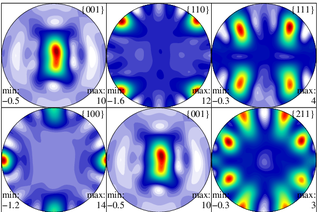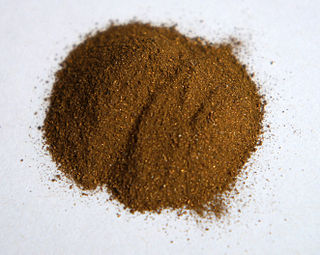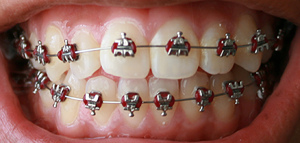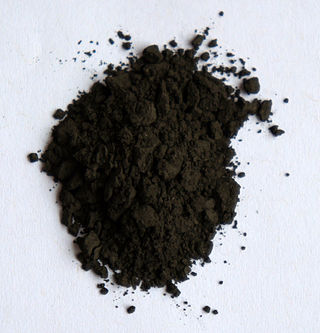Related Research Articles

Titanium is a chemical element; it has symbol Ti and atomic number 22. Found in nature only as an oxide, it can be reduced to produce a lustrous transition metal with a silver color, low density, and high strength, resistant to corrosion in sea water, aqua regia, and chlorine.

High-strength low-alloy steel (HSLA) is a type of alloy steel that provides better mechanical properties or greater resistance to corrosion than carbon steel. HSLA steels vary from other steels in that they are not made to meet a specific chemical composition but rather specific mechanical properties. They have a carbon content between 0.05 and 0.25% to retain formability and weldability. Other alloying elements include up to 2.0% manganese and small quantities of copper, nickel, niobium, nitrogen, vanadium, chromium, molybdenum, titanium, calcium, rare-earth elements, or zirconium. Copper, titanium, vanadium, and niobium are added for strengthening purposes. These elements are intended to alter the microstructure of carbon steels, which is usually a ferrite-pearlite aggregate, to produce a very fine dispersion of alloy carbides in an almost pure ferrite matrix. This eliminates the toughness-reducing effect of a pearlitic volume fraction yet maintains and increases the material's strength by refining the grain size, which in the case of ferrite increases yield strength by 50% for every halving of the mean grain diameter. Precipitation strengthening plays a minor role, too. Their yield strengths can be anywhere between 250–590 megapascals (36,000–86,000 psi). Because of their higher strength and toughness HSLA steels usually require 25 to 30% more power to form, as compared to carbon steels.

In physical chemistry and materials science, texture is the distribution of crystallographic orientations of a polycrystalline sample. A sample in which these orientations are fully random is said to have no distinct texture. If the crystallographic orientations are not random, but have some preferred orientation, then the sample has a weak, moderate or strong texture. The degree is dependent on the percentage of crystals having the preferred orientation.

Titanium nitride is an extremely hard ceramic material, often used as a physical vapor deposition (PVD) coating on titanium alloys, steel, carbide, and aluminium components to improve the substrate's surface properties.
Titanium alloys are alloys that contain a mixture of titanium and other chemical elements. Such alloys have very high tensile strength and toughness. They are light in weight, have extraordinary corrosion resistance and the ability to withstand extreme temperatures. However, the high cost of both raw materials and processing limit their use to military applications, aircraft, spacecraft, bicycles, medical devices, jewelry, highly stressed components such as connecting rods on expensive sports cars and some premium sports equipment and consumer electronics.

An implant is a medical device manufactured to replace a missing biological structure, support a damaged biological structure, or enhance an existing biological structure. For example, an implant may be a rod, used to strengthen weak bones. Medical implants are human-made devices, in contrast to a transplant, which is a transplanted biomedical tissue. The surface of implants that contact the body might be made of a biomedical material such as titanium, silicone, or apatite depending on what is the most functional. In 2018, for example, American Elements developed a nickel alloy powder for 3D printing robust, long-lasting, and biocompatible medical implants. In some cases implants contain electronics, e.g. artificial pacemaker and cochlear implants. Some implants are bioactive, such as subcutaneous drug delivery devices in the form of implantable pills or drug-eluting stents.

Microstructure is the very small scale structure of a material, defined as the structure of a prepared surface of material as revealed by an optical microscope above 25× magnification. The microstructure of a material can strongly influence physical properties such as strength, toughness, ductility, hardness, corrosion resistance, high/low temperature behaviour or wear resistance. These properties in turn govern the application of these materials in industrial practice.

An archwire in orthodontics is a wire conforming to the alveolar or dental arch that can be used with dental braces as a source of force in correcting irregularities in the position of the teeth. An archwire can also be used to maintain existing dental positions; in this case it has a retentive purpose.

Titanium hydride normally refers to the inorganic compound TiH2 and related nonstoichiometric materials. It is commercially available as a stable grey/black powder, which is used as an additive in the production of Alnico sintered magnets, in the sintering of powdered metals, the production of metal foam, the production of powdered titanium metal and in pyrotechnics.
In metallurgy, solid solution strengthening is a type of alloying that can be used to improve the strength of a pure metal. The technique works by adding atoms of one element to the crystalline lattice of another element, forming a solid solution. The local nonuniformity in the lattice due to the alloying element makes plastic deformation more difficult by impeding dislocation motion through stress fields. In contrast, alloying beyond the solubility limit can form a second phase, leading to strengthening via other mechanisms.
Electron-beam additive manufacturing, or electron-beam melting (EBM) is a type of additive manufacturing, or 3D printing, for metal parts. The raw material is placed under a vacuum and fused together from heating by an electron beam. This technique is distinct from selective laser sintering as the raw material fuses have completely melted. Selective Electron Beam Melting (SEBM) emerged as a powder bed-based additive manufacturing (AM) technology and was brought to market in 1997 by Arcam AB Corporation headquartered in Sweden.
Vacuum arc remelting (VAR) is a secondary melting process for production of metal ingots with elevated chemical and mechanical homogeneity for highly demanding applications. The VAR process has revolutionized the specialty traditional metallurgical techniques industry, and has made possible tightly-controlled materials used in biomedical, aviation and aerospace.

Bioceramics and bioglasses are ceramic materials that are biocompatible. Bioceramics are an important subset of biomaterials. Bioceramics range in biocompatibility from the ceramic oxides, which are inert in the body, to the other extreme of resorbable materials, which are eventually replaced by the body after they have assisted repair. Bioceramics are used in many types of medical procedures. Bioceramics are typically used as rigid materials in surgical implants, though some bioceramics are flexible. The ceramic materials used are not the same as porcelain type ceramic materials. Rather, bioceramics are closely related to either the body's own materials or are extremely durable metal oxides.
Ti-6Al-4V, also sometimes called TC4, Ti64, or ASTM Grade 5, is an alpha-beta titanium alloy with a high specific strength and excellent corrosion resistance. It is one of the most commonly used titanium alloys and is applied in a wide range of applications where low density and excellent corrosion resistance are necessary such as e.g. aerospace industry and biomechanical applications.

Titanium was first introduced into surgeries in the 1950s after having been used in dentistry for a decade prior. It is now the metal of choice for prosthetics, internal fixation, inner body devices, and instrumentation. Titanium is used from head to toe in biomedical implants. One can find titanium in neurosurgery, bone conduction hearing aids, false eye implants, spinal fusion cages, pacemakers, toe implants, and shoulder/elbow/hip/knee replacements along with many more. The main reason why titanium is often used in the body is due to titanium's biocompatibility and, with surface modifications, bioactive surface. The surface characteristics that affect biocompatibility are surface texture, steric hindrance, binding sites, and hydrophobicity (wetting). These characteristics are optimized to create an ideal cellular response. Some medical implants, as well as parts of surgical instruments are coated with titanium nitride (TiN).
A simulated body fluid (SBF) is a solution with an ion concentration close to that of human blood plasma, kept under mild conditions of pH and identical physiological temperature. SBF was first introduced by Kokubo et al. in order to evaluate the changes on a surface of a bioactive glass ceramic. Later, cell culture media, in combination with some methodologies adopted in cell culture, were proposed as an alternative to conventional SBF in assessing the bioactivity of materials.
Bioresorbablemetals are metals or their alloys that degrade safely within the body. The primary metals in this category are magnesium-based and iron-based alloys, although recently zinc has also been investigated. Currently, the primary uses of bioresorbable metals are as stents for blood vessels and other internal ducts.
Titanium foams exhibit high specific strength, high energy absorption, excellent corrosion resistance and biocompatibility. These materials are ideally suited for applications within the aerospace industry. An inherent resistance to corrosion allows the foam to be a desirable candidate for various filtering applications. Further, titanium's physiological inertness makes its porous form a promising candidate for biomedical implantation devices. The largest advantage in fabricating titanium foams is that the mechanical and functional properties can be adjusted through manufacturing manipulations that vary porosity and cell morphology. The high appeal of titanium foams is directly correlated to a multi-industry demand for advancement in this technology.
Quality requirements of welded joints depend on the form of application, e.g. in the space or fly industry weld errors are not allowed. Science try to gets good quality welds. There are many scientific articles describing the weld test, e.g. hardness, tensile tests. The weld structure can be examined by optical microscopy and scanning electron microscopy. The computer finite element method (FEM) is used to predict the shape of the flash and interface and others, not only for rotary friction welding (RFW), but also for friction stir welding (FSW), linear friction welding (LFW), FRIEX, and others. Temperature measurements are also carried out for scientific purposes e.g. by use thermocouples or sometimes thermography, mentions about measurements are generally found in research materials and journals.
References
- ↑ Fellah, Mamoun; Labaïz, Mohamed; Assala, Omar; Dekhil, Leila; Taleb, Ahlem; Rezag, Hadda; Iost, Alain (21 July 2014). "Tribological behavior of Ti-6Al-4V and Ti-6Al-7Nb Alloys for Total Hip Prosthesis". Advances in Tribology. 2014: 1–13. doi: 10.1155/2014/451387 . hdl: 10985/9566 .
- ↑ Chlebus, Edward; Kuźnicka, Bogumiła; Kurzynowski, Tomasz; Dybała, Bogdan (1 May 2011). "Microstructure and mechanical behaviour of Ti―6Al―7Nb alloy produced by selective laser melting". Materials Characterization. 62 (5): 488–495. doi:10.1016/j.matchar.2011.03.006.
- ↑ Liu, Xuanyong; Chu, Paul K.; Ding, Chuanxian (24 December 2004). "Surface modification of titanium, titanium alloys, and related materials for biomedical applications". Materials Science and Engineering: R: Reports. 47 (3): 49–121. CiteSeerX 10.1.1.472.7717 . doi:10.1016/j.mser.2004.11.001.
- ↑ López, M. F; Gutiérrez, A; Jiménez, J. A (15 February 2002). "In vitro corrosion behaviour of titanium alloys without vanadium". Electrochimica Acta. 47 (9): 1359–1364. doi:10.1016/S0013-4686(01)00860-X.
- ↑ Lütjering, G. (15 March 1998). "Influence of processing on microstructure and mechanical properties of (α+β) titanium alloys". Materials Science and Engineering: A. 243 (1): 32–45. doi:10.1016/S0921-5093(97)00778-8.
- ↑ Ajeel, Sami Abualnoun; Alzubaydi, Thair L.; Swadi, Abdulsalam K. (2007). "Influence of Heat Treatment Conditions on Microstructure of Ti- 6Al-7Nb Alloy As Used Surgical Implant Materials". Engineering and Technology Journal. 25 (Suppl 3): 431–442. doi:10.30684/etj.25.3.15. S2CID 55885379.
- ↑ "Properties: Titanium Alloys - Ti6Al7Nb Properties and Applications".
- ↑ Kobayashi, E.; Wang, T.J.; Doi, H.; Yoneyama, T.; Hamanaka, H. (1998). "Mechanical properties and corrosion resistance of Ti–6Al–7Nb alloy dental castings". Journal of Materials Science: Materials in Medicine. 9 (10): 567–574. doi:10.1023/A:1008909408948. PMID 15348689. S2CID 13241089.
- ↑ Bolzoni, Leandro; Hari Babu, N.; Ruiz-Navas, Elisa Maria; Gordo, Elena (2013). "Comparison of Microstructure and Properties of Ti-6Al-7Nb Alloy Processed by Different Powder Metallurgy Routes". Key Engineering Materials. 551: 161–179. doi:10.4028/www.scientific.net/KEM.551.161. hdl: 10016/20805 . S2CID 137360703.
- ↑ Oliveira, V.; Chaves, R. R.; Bertazzoli, R.; Caram, R. (December 1998). "Preparation and characterization of Ti-Al-Nb alloys for orthopedic implants". Brazilian Journal of Chemical Engineering. 15 (4): 326–333. doi: 10.1590/S0104-66321998000400002 . S2CID 94310566.
- ↑ Sercombe, Tim; Jones, Noel; Day, Rob; Kop, Alan (26 September 2008). "Heat treatment of Ti-6Al-7Nb components produced by selective laser melting". Rapid Prototyping Journal. 14 (5): 300–304. doi:10.1108/13552540810907974.
- ↑ Sercombe, Tim; Jones, Noel; Day, Rob; Kop, Alan (26 September 2008). "Heat treatment of Ti-6Al-7Nb components produced by selective laser melting". Rapid Prototyping Journal. 14 (5): 300–304. doi:10.1108/13552540810907974.
- ↑ Lütjering, G. (15 March 1998). "Influence of processing on microstructure and mechanical properties of (α+β) titanium alloys". Materials Science and Engineering: A. 243 (1): 32–45. doi:10.1016/S0921-5093(97)00778-8.
- ↑ Elias, C. N.; Lima, J. H. C.; Valiev, R.; Meyers, M. A. (1 March 2008). "Biomedical applications of titanium and its alloys". JOM. 60 (3): 46–49. Bibcode:2008JOM....60c..46E. doi:10.1007/s11837-008-0031-1. S2CID 12056136.
- ↑ Kobayashi, E.; Wang, T.J.; Doi, H.; Yoneyama, T.; Hamanaka, H. (1 October 1998). "Mechanical properties and corrosion resistance of Ti–6Al–7Nb alloy dental castings". Journal of Materials Science: Materials in Medicine. 9 (10): 567–574. doi:10.1023/A:1008909408948. PMID 15348689. S2CID 13241089.
- ↑ Disegi, John (November 2008). Implant Materials (PDF) (2nd ed.). Synthes. Archived from the original (PDF) on 11 December 2015.
- ↑ Milne, Ian; Ritchie, R. O.; Karihaloo, B. L. (25 July 2003). Standardized titanium and titanium alloys. Elsevier. p. 163. ISBN 9780080490731. in Sumita, M.; Hanawa, T.; Ohnishi, I.; Yoneyama, T. (2003). "Failure Processes in Biometallic Materials". Comprehensive Structural Integrity. pp. 131–167. doi:10.1016/B0-08-043749-4/09143-6. ISBN 978-0-08-043749-1.